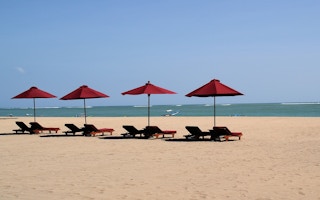The travel-related implications of the coronavirus disease (Covid-19) outbreak have been unprecedented and fast-changing. According to the World Tourism Organisation, at the height of the crisis, travel was brought to a virtual standstill with every destination worldwide imposing travel restrictions on foreign nationals—a historic first.
The travel and tourism industry is among the sectors most affected by the Covid-19 crisis and is set to have its largest economic fallout in history. In the Asia and Pacific region, in particular, travel and tourism are inextricably linked to economic wellbeing: the industry accounts for as much as 80 per cent of GDP in some countries.
A recent assessment by the World Travel and Tourism Council projects a global loss of more than 100 million jobs and $2.7 trillion in revenue due to Covid-19 related restrictions. The Asia and Pacific region alone stands to lose approximately 63 million jobs and $1 trillion in GDP.
Even as travel restrictions and lockdowns have relaxed, cautious return-to-travel behavior among travelers—due in part to lingering health and safety concerns—suggests that the recovery process for the industry will be long and slow.
“
In the Asia and Pacific region, in particular, travel and tourism are inextricably linked to economic wellbeing: the industry accounts for as much as 80 per cent of GDP in some countries.
Although the world is still deep in the trenches of battling Covid-19, many countries have started to slowly re-open their borders. At the same time a number of actions have been taken to restart travel and tourism—including governments providing stimulus and recovery packages, airlines and hospitality partners stepping up health and safety measures, and airline manufacturers enhancing aircraft air filtration systems and researching new disinfectant technologies.
With health, hygiene, and safety identified as top priorities for travelers, several efforts to develop a harmonised set of health and safety protocols for the travel and tourism industry—led by both industry and global health experts—are also underway.
Given the broad range of stakeholders involved in a traveller’s journey from one destination to another—including the private sector (e.g., airlines and tourism and travel industry partners) and public entities (e.g., airport authorities and ministries of home affairs, finance, transport, and health)—multisectoral collaboration in the development of these protocols is key.
Although efforts to develop industry guidance are still in the early stages and specific practices may vary from one operating environment to another, there are several key steps that travel and tourism stakeholders can consider now to kickstart the recovery process. Noting that some are temporary relief measures and will eventually be withdrawn (e.g., physical distancing), while others may mark a more permanent shift in practices, they include:
Develop a health and safety communications plan
In order to increase customer confidence and ease travelers’ fears about travel-related risks, travel stakeholders should put into place communication plans to update the public about any new travel health and security related information.
This includes information on any new health and hygiene safety protocols once they have been implemented, as well as any other public health emergencies in the future. The most effective communication will focus on clear, consistent, and transparent messaging on potential health risks as well as mitigation measures, and be widely disseminated through both digital and print platforms (e.g., posters, information displays, etc.).
Train staff in current health guidelines and make personal protective equipment available
Until a safe vaccine is made widely available, travel stakeholders should aim to reduce Covid-19 transmission pathways. While health guidelines will continue to adjust in line with the trajectory of the disease, there are a number of simple measures that can be adopted now in accordance with best practices.
This includes ensuring that staff are fully familiar with, trained in, and adhere to current health guidelines around physical distancing, wearing face masks, and increased hand-washing. In addition, businesses should maintain an adequate supply of task-appropriate personal protection equipment (e.g., masks, gloves, face shields, etc.) for staff to ensure that they remain protected.
Introduce enhanced cleaning and sanitation procedures
Good hand hygiene and proper disinfection practices are necessary to protect against Covid-19. In light of this, travel stakeholders should introduce enhanced cleaning regimes—ensuring that frequently used equipment and infrastructure are sanitised regularly according to the latest global health guidance.
They should also ensure that hand sanitising gel is easily made available, with a specific focus on high-frequency touch points. This guidance should be applied across travel environments—from airports, airplanes and transfer buses, to hotels and restaurants. Where appropriate, businesses in the travel industry (e.g., hotels, airports) should also increase the use of air conditioning and effective filtration systems to keep air clean, improve air flow, reduce recirculation, and increase the fresh-air exchange.
Enhance facilities to minimise person-to-person interactions
Using technology and other strategies to reduce person-to-person interactions is an important consideration in reducing risk of Covid-19 infections. There are a number of ways in which travel stakeholders can upgrade or enhance facilities to encourage physical distancing and to minimise touchpoints.
This might include modifying passenger/customer flow by placing directional markers on the floor to indicate where people should stand. It might also include introducing capacity limits where possible (e.g., in elevators) to reduce over-crowding or restricting access to high-risk areas in airports and hotels (e.g., water fountains, play areas). In situations where physical distancing cannot be maintained, travel stakeholders should consider installing transparent protective barriers to provide physical distance between customers and employees. Travel stakeholders should also consider minimising physical contact through touchless technological solutions (e.g., self-check in at hotels and airports, digital menus).
Promote more robust health screening and contact tracing
Finally, travel stakeholders should review their policies and adopt health screening procedures in line with recommended guidance. This might include updating sick leave policies and ensuring staff health is monitored by recommending that they do not report to work, get tested, and self-isolate if they show any symptoms of Covid-19.
Other measures might include using health screening questionnaires for travelers arriving from ‘at-risk’ areas or providing additional human and financial resources to port health authorities. Travel stakeholders should also collaborate with local health departments to collect information necessary for contact tracing and notification of individuals in the event of exposure. Where possible, these processes can be integrated to ensure that travel and health authorities are working together.
Covid-19 has triggered major shifts across the globe and its ripple effects, especially on the travel and tourism industry, will likely be felt for years to come. With a number of unknowns—including the trajectory of the pandemic and the levels of travel-related cooperation between countries—the immediate future of travel still remains uncertain.
However, stakeholders across the industry, including governments, have an opportunity to prepare for the long haul of recovery. This includes not only collaborating on new and necessary health and safety protocols, but also fostering technological innovation in travel and tourism and redefining the sector so that, ultimately, it is more resilient moving forward.
Patrick L. Osewe is Chief of the Asian Development Bank’s (ADB) Health Sector Group. This article is republished from the ADB Blog.













